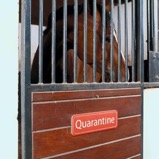
February 2019
Equine Biosecurity: Preventing Disease Outbreaks
Tips from Katie Delph, DVM, MS, DACVIM-LAIM

|
| Photo source |
As we are all dreaming about and making plans for when the weather warms up, it’s important to keep in mind how to keep our horses safe from contagious diseases when traveling. It can be the furthest thing from our minds when preparing for an event or planning on a relaxing weekend trail riding; but if you prepare ahead of time, it will be second nature. Below are a few tips for keeping your horses safe while on the road.
-
Use biosecurity precautions while at events
-
Avoid nose-to-nose contact with other horses
-
Avoid sharing equipment
-
-
- Disinfect stalls or other permanent equipment
-
Appropriately vaccinate based on your veterinarian’s recommendations and your horse’s risks
-
When traveling with your horse, a Coggins test should be up-to-date and a health certificate performed, when appropriate (for example, traveling out of your home state)
-
Contact your veterinarian or KSU-VHC for testing and questions.
-
-
Avoid traveling with your horse when they are ill
-
This will prevent the spread of infectious disease
-
It will also decrease the likelihood of your horse becoming ill if exposed to other contagious illnesses
-
-
Monitor your horses while away and when returned home
-
Watch for signs of decreased appetite or lethargy
-
Watch for nasal discharge, diarrhea, or neurologic signs
-
Check rectal temperature
-
Contact your veterinarian or the KSU-VHC if you notice these signs or your horses is febrile (>102.0 F)
-
- Quarantine the traveling horse from other horses on the farm when returning home
-
If any horses are ill at the event
-
Keep up-to-date on potential outbreaks in the areas you are traveling to by visiting the Equine Disease Communication Center at www.equinediseasecc.org
- If there are any immunosuppressed horses (old, young, or ill) on the farm at home
-
If you are contemplating a new horse this spring, keep in mind that new additions to the herd should be quarantined also to prevent the introduction of disease to your existing herd.

|
| Photo source |
-
Make a quarantine plan with your veterinarian’s advice
-
Quarantine for at least 3 weeks
-
Housed in a separate area
-
No nose-to-nose contact
-
No shared turnout
-
No shared equipment
-
-
Monitor for any signs of disease
-
Fever
-
Nasal discharge
-
Diarrhea
-
Neurologic signs like incoordination
-
-
Investigate any signs with your veterinarians
-
Depending on your veterinarian’s recommendations, diagnostic testing can be performed prior to introduction to the herd if the horse is from a higher risk environment
Some of these recommendations may seem tedious; however, if they prevent disease occurrence/spread and the need for time-/labor-consuming practices, they will be well worth your efforts.
Contact your veterinarian or the veterinarians at the KSU-VHC at (785) 532-5700 if you have any questions or need advice instituting a quarantine plan.